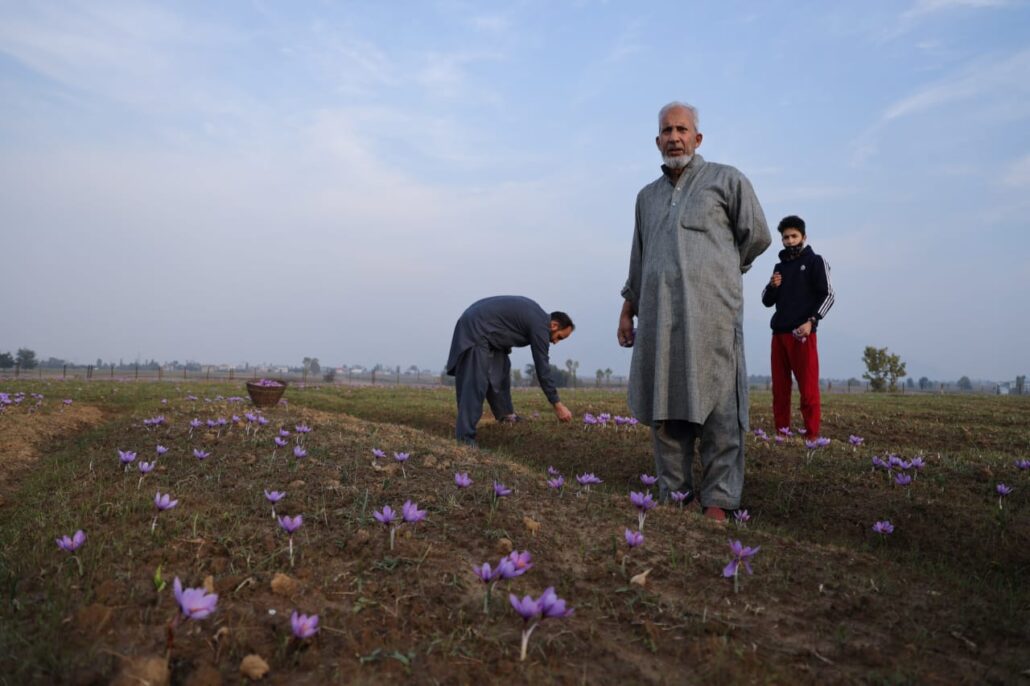“I know shifting to oilseed cultivation from saffron sounds a bit unusual, but the losses in saffron cultivation forced this change,” laments Gulzar Ahmad, a Saffron farmer with vast tracts of land in Lalpora, just 3 km from Pampore town in south Kashmir’s Pulwama district.
Each year, Gulzar eagerly awaited saffron harvest from his sprawling 20 kanal field, However, the year brought an unexpected shift. Ahmad, like many farmers in Konubal, Dusoo, Munpora Ladhoo, and other saffron-producing villages, turned to mustard cultivation.
The tales of shifting crops echo through the saffron-rich landscapes of Kashmir, painting a narrative of adversity and transformation.
In the heart of the picturesque Kashmir Valley, globally renowned for its saffron, a looming threat has cast shadows over the vibrant fields. Saffron farmers bemoan the increasing industrial pollution, Indian crested porcupines drawn into the saffron farms in search of food amid diminishing forest cover.
This encroachment, coupled with the challenges posed by climate change, has led to a significant decline in saffron production.
The Impact of Porcupine Intrusions
Kashmir stands as India’s beacon of saffron production, contributing about seven percent to the world’s saffron output, second only to Iran. Pampore, nestled in Kashmir’s Pulwama district, has been the heart of this saffron-rich region, producing a staggering 90 percent of India’s saffron.
However, recent years have witnessed a concerning trend. Experts estimate the loss of nearly 5,000 hectares of saffron fields due to porcupine intrusions, exacerbating the struggles faced by farmers.
According to Nisar Ahmad Kongwani, a distressed farmer and saffron trader, “We sincerely hope for some solution. There was a time when the least a farmer would produce was between 30 to 40 kg, but now, the produce is very little, as little as between 5 to 10 kg every year.”
Climate Change and Agricultural Challenges
Climate change further compounds the challenges confronting saffron cultivation in Kashmir. The region experiences a rainfall deficit, unseasonal snowfall, and other environmental factors, taking a heavy toll on saffron production. Official data reveals a staggering 65 percent drop in saffron production over the past two decades. The land under saffron cultivation has shrunk from 5707 hectares in 1996 to 3875 hectares in 2010-11.
A concerned citizen, who chose anonymity, sheds light on the transformations in the saffron landscape, stating, “Many farmers converted the saffron land either into orchards or used it for construction. However, they quickly added that they grew mustard as a rotational crop.”
Government Interventions and Their Shortcomings
In an attempt to salvage saffron cultivation, the government introduced the Jammu and Kashmir Saffron Act in 2007, prohibiting the conversion of saffron land. The Rs 412-crore National Saffron Mission, rolled out in 2010, aimed to combat protracted dry spells through the introduction of drip irrigation.
However, farmers express dissatisfaction, highlighting operational shortcomings. A farmer from the Chatlam area laments, “The dripping system was not made functional in our area. I can’t speak for other areas.”
Director of Agriculture Kashmir, Choudhary Muhammad Iqbal, attributes low production to various factors, including the uprooting of pipes from fields and the engagement of migrant laborers with limited knowledge of saffron farming.
Industrial Intrusions and Cement Dust Woes
Adding to the woes of saffron farmers, industrial intrusions, particularly from cement factories, further imperil the delicate saffron produce. The Khreev area of Pampore in Pulwama, once renowned as Saffron Town, is now witnessing a decline in saffron cultivation.
Mohammad Maqbool, a saffron farmer in Khrew, highlights the adverse impact of the cement business on saffron productivity and quality.
Abdul Majeed Wani, President of the Saffron Producers Organization, voices concerns, stating, “Due to the dust coming out from the cement factories, farming is not being done in the fields adjacent to the cement factories. Farmers have either sold those lands at higher prices or left the land vacant.” The expanding footprint of cement factories poses a threat to saffron fields, as cement dust mixes with dew drops and adheres to the flowers, affecting both quality and yield.
The saffron fields of Kashmir, once vibrant and emblematic of the region’s identity, now face multifaceted challenges. Porcupine intrusions, climate change, insufficient government interventions, and industrial encroachments collectively pose a formidable threat to saffron cultivation.
The resilience of farmers, like Gulzar Ahmad, adapting to alternative crops, reflects the profound impact of these challenges on the traditional saffron landscape.
As Kashmir’s saffron fields navigate this intricate web of adversities, the urgent need for comprehensive solutions and sustained conservation efforts becomes increasingly apparent.
The fragility of this prized saffron produce underscores the delicate balance between agricultural traditions and the evolving landscape of Kashmir.
The challenges faced by Kashmir’s saffron cultivation find an echo in global research. In 2021, researchers Wei Wei and Zanxin Wang from Henan University conducted a comprehensive study titled “Impact of Industrial Air Pollution on Agricultural Production.”
This investigation explored the worldwide implications of industrial air pollution, uncovering its adverse effects on human health and agricultural activities, resulting in significant welfare losses. Identifying four primary sources of air pollutants linked to industrial activities, the study delved into their intricate impact on agricultural productivity.
From disrupting biochemical and physiological reactions in plants to causing soil degradation through acid rain, the research highlighted the multifaceted consequences.
The economic ramifications on crop growth and yield, indicated by substantial global losses, underscored the severity of the issue.
This research gains particular relevance when applied to the challenges confronted by saffron cultivation in Kashmir, where air pollution from cement factories and porcupine intrusion pose threats to the prized saffron produce.
